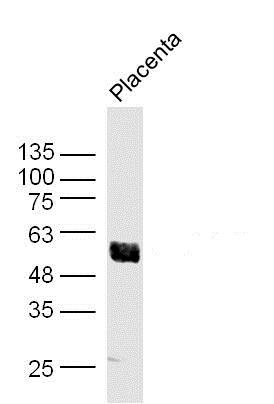phospho-Akt (Thr308) Polyclonal Antibody
BS-2720R
ApplicationsFlow Cytometry, ImmunoFluorescence, Western Blot, ImmunoHistoChemistry, ImmunoHistoChemistry Frozen, ImmunoHistoChemistry Paraffin
Product group Antibodies
ReactivityBovine, Human, Mouse, Rat
TargetAKT1
Overview
- SupplierBioss
- Product Namephospho-Akt (Thr308) Polyclonal Antibody
- Delivery Days Customer16
- ApplicationsFlow Cytometry, ImmunoFluorescence, Western Blot, ImmunoHistoChemistry, ImmunoHistoChemistry Frozen, ImmunoHistoChemistry Paraffin
- Applications SupplierWB(1:300-5000), IHC-P(1:200-400), IHC-F(1:100-500), IF(), Flow-Cyt(1ug/Test)
- CertificationResearch Use Only
- ClonalityPolyclonal
- Concentration1 ug/ul
- ConjugateUnconjugated
- Gene ID207
- Target nameAKT1
- Target descriptionAKT serine/threonine kinase 1
- Target synonymsAKT, PKB, PKB-ALPHA, PRKBA, RAC, RAC-ALPHA, RAC-alpha serine/threonine-protein kinase, AKT1m, PKB alpha, RAC-PK-alpha, protein kinase B alpha, proto-oncogene c-Akt, rac protein kinase alpha, serine-threonine protein kinase, v-akt murine thymoma viral oncogene homolog 1, v-akt murine thymoma viral oncogene-like protein 1
- HostRabbit
- IsotypeIgG
- ReactivityBovine, Human, Mouse, Rat
- Storage Instruction-20°C
- UNSPSC12352203
References
- Wang Y, Zhao H, Guo M, et al. Targeting the miR-122/PKM2 autophagy axis relieves arsenic stress. J Hazard Mater. 2020,383:121217. doi: 10.1016/j.jhazmat.2019.121217Read this paper
- Wang Z, Kuang G, Yu Z, et al. Light-activatable dual prodrug polymer nanoparticle for precise synergistic chemotherapy guided by drug-mediated computed tomography imaging. Acta Biomater. 2019,94:459-468. doi: 10.1016/j.actbio.2019.05.047Read this paper
- Zheng R, Huang S, Zhu J, et al. Leucine attenuates muscle atrophy and autophagosome formation by activating PI3K/AKT/mTOR signaling pathway in rotator cuff tears. Cell Tissue Res. 2019,378(1):113-125. doi: 10.1007/s00441-019-03021-xRead this paper
- Ou X, Zhang GT, Xu Z, et al. Desumoylating Isopeptidase 2 (DESI2) Inhibits Proliferation and Promotes Apoptosis of Pancreatic Cancer Cells through Regulating PI3K/AKT/mTOR Signaling Pathway. Pathol Oncol Res. 2019,25(2):635-646. doi: 10.1007/s12253-018-0487-4Read this paper
- Li C, Xin P, Xiao H, et al. The dual PI3K/mTOR inhibitor NVP-BEZ235 inhibits proliferation and induces apoptosis of burkitt lymphoma cells. Cancer Cell Int. 2015,15:65. doi: 10.1186/s12935-015-0213-1Read this paper





